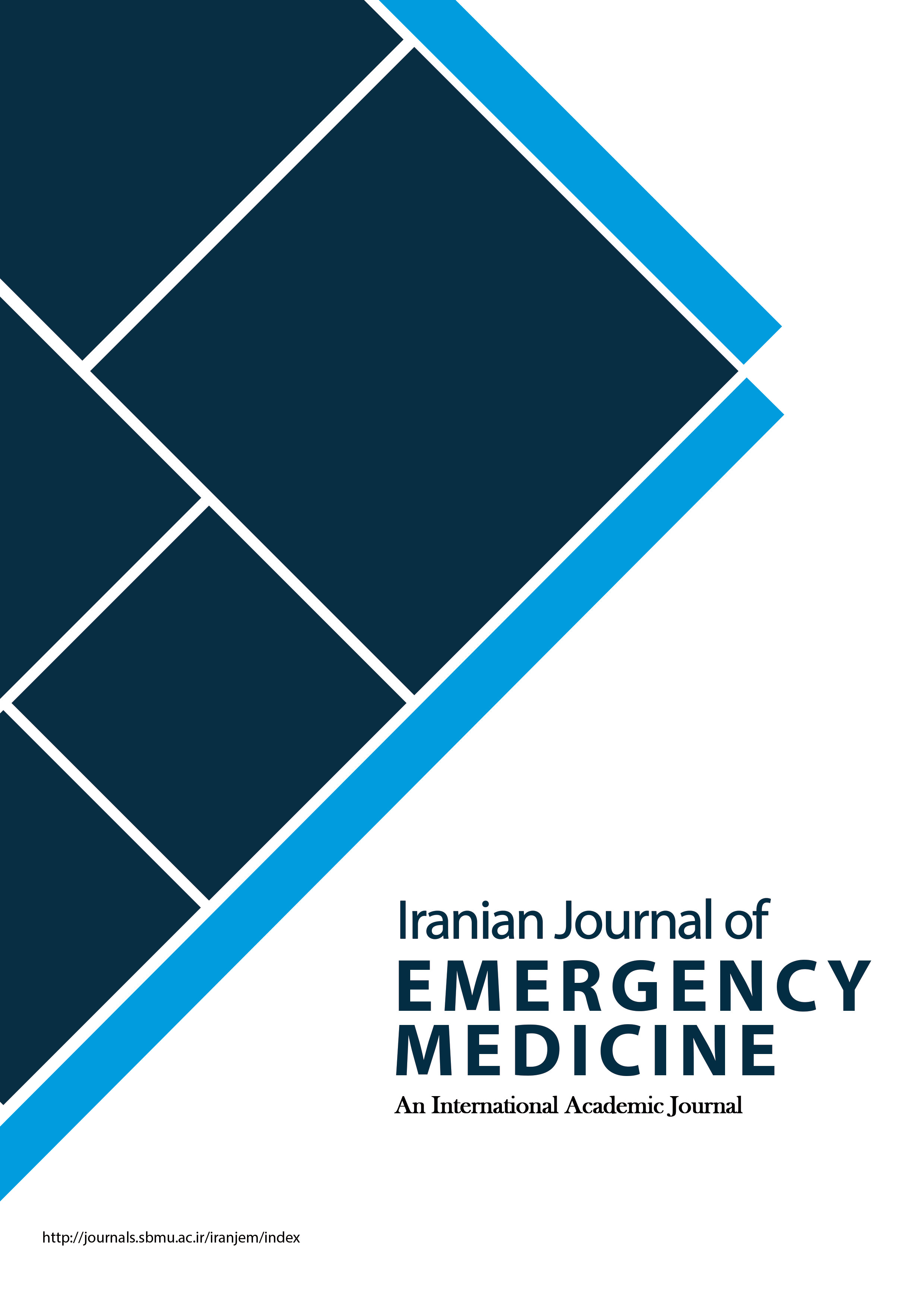Quality of Nursing Care and Documentation with Overcrowding in Emergency Department
Iranian Journal of Emergency Medicine,
Vol. 3 No. 2 (2016),
6 June 2016
,
Page 57-53
https://doi.org/10.22037/ijem.v3i2.9975
Abstract
Introduction: Overcrowding in the emergency department is a major obstacle in receiving care. The present study was done with the aim of evaluating the relationship of nursing care and documentation qualities with overcrowding in emergency department. Methods: The present cross-sectional study was carried out in Alzahra Hospital, Isfahan, Iran in 2012. Data were gathered by a trained observer throughout working hours of the hospital using a standard checklist extracted from nursing textbooks. Overcrowded shifts were separated from other shifts by considering the number of patients admitted, and results were compared between the 2 situations using statistical analyses. Results: 170 patient files were evaluated regarding the quality of nursing and its documentation. According to the statistical analyses, documenting the nursing care given decreased at overcrowded times (p = 0.028), however the quality of care given did not vary (p = 0.36). Conclusion: The results of this study showed that despite the decline in quality of nursing care documentation following overcrowding in emergency department, rate and quality of care were not affected by overcrowding.- بخش اورژانس؛ پرستاری؛ ثبت؛ مدیریت اطلاعات
How to Cite
References
Derlet RW. Overcrowding in US EDs: A critical condition. The California Journal of Emergency Medicine. 2002;3(2):24.
Shahrami A, Rahmati F, Kariman H, Hashemi B, Rahmati M, Baratloo A, et al. Utilization of Failure Mode and Effects Analysis (FMEA) Method in Increasing the Revenue of Emergency Department; a Prospective Cohort Study. Emergency. 2013;1(1):1.
Rahmati F, Shahrami A, Baratloo A, Hashemi B, Mahdavi NS, Safari S, et al. Failure Mode and Effect Analysis in Increasing the Revenue of Emergency Department. Iranian Journal of Emergency Medicine. 2015;2(1):pp. 20-7.
Hashemi B, Baratloo A, Forouzafar MM, Motamedi M, Tarkhorani M. Patient Satisfaction Before and After Executing Health Sector Evolution Plan. Iranian Journal of Emergency Medicine. 2015;2(3):127-33.
VAFAEE A, ALAMDARI S, KARIMAN H, ARHAMI DA, AMINI A, SHAHRAMI A, et al. Design Patterns in the Crisis Management Shohada hospital. 2011.
Asplin BR, Magid DJ, Rhodes KV, Solberg LI, Lurie N, Camargo CA. A conceptual model of emergency department crowding. Annals of emergency medicine. 2003;42(2):173-80.
Baratloo A, Rahmati F, Forouzanfar MM, Hashemi B, Motamedi M, Safari S. Evaluation of Performance Indexes of Emergency Department. Iranian Journal of Emergency Medicine. 2015;2(1):pp. 33-8.
Sprivulis PC, Da Silva J, Jacobs IG, Frazer AR, Jelinek GA. The association between hospital overcrowding and mortality among patients admitted via Western Australian emergency departments. Medical Journal of Australia. 2006;184(5):208.
Latham LP, Ackroyd-Stolarz S. Emergency Department Utilization by Older Adults: a Descriptive Study. Canadian Geriatrics Journal. 2014;17(4):118.
Hatamabadi H, Alimohammadi H. Reasons for long-stay admission in a typical overcrowded emergency of a teaching hospital in Tehran capital city. Pajoohandeh Journal. 2008;13(1):71-5.
Hosseini H, Daryabeigi R, Mashhadizadeh A. A survey on processing measurements and structural standard compliance in emergency wards. Iranian Journal of Nursing and Midwifery Research. 2010;8(3).
Forouzanfar MM, Alitaleshi H, Hashemi B, Baratloo A, Motamedi M, Majidi A, et al. Emergency nurses ‘job satisfaction and its determinants. Journal of Shahid Beheshti School of Nursing & Midwifery. 2013;23(80).
Wang SJ, Middleton B, Prosser LA, Bardon CG, Spurr CD, Carchidi PJ, et al. A cost-benefit analysis of electronic medical records in primary care. The American journal of medicine. 2003;114(5):397-403.
Blair W, Smith B. Nursing documentation: Frameworks and barriers. Contemporary nurse. 2012;41(2):160-8.
Accordino R, Kopple-Perry N, Gligorov N, Krieger S. The medical record as legal document: When can the patient dictate the content? An ethics case from the Department of Neurology. Clinical Ethics. 2014:1477750913517572.
Darmer MR, Ankersen L, Nielsen BG, Landberger G, Lippert E, Egerod I. The effect of a VIPS implementation programme on nurses’ knowledge and attitudes towards documentation. Scandinavian journal of caring sciences. 2004;18(3):325-32.
Anderson DJ, Webster CS. A systems approach to the reduction of medication error on the hospital ward. Journal of advanced nursing. 2001;35(1):34-41.
Tapp RA. Inhibitors and facilitators to documentation of nursing practice. Western journal of nursing research. 1990;12(2):229-40.
Nursing Organization of Islamic Republic of Iran. Nursing practice guideline. 4 ed. Tehran: ponehn; 2009.
Sedghiyani E. Evaluation of health care and hospital standards. Tehran: Moein Publication. 2005.
Gunther M, Thomas SP. Nurses' narratives of unforgettable patient care events. Journal of Nursing Scholarship. 2006;38(4):370-6.
Rangraz. F FM, Moosavi. G. Study of Patients’ Information Records in Emergency Wards in Kashan Hospitals. feyz. 2002;31(3):61-73.
Esmailian M, Nasr-Esfahani M. The Quality of Patients’ Files Documentation in Emergency Department; a Cross Sectional Study. Iranian Journal of Emergency Medicine. 2014;1(1):pp. 16-21.
Hashemi M, Garshad A. ASSESMENT JOB STRESS IT IN NURSING PERSONAL IN A SELECTED TEACHING HOSPITAL OF NORTH KHORASAN UNIVERSITY OF MEDICAL SCIENCES 2008. 2012.
Jasemi M, Mohajal Aghdam A, Rahmani A, Abdollahzadeh F, Zamanzadeh V. Assessing quality of nursing documentations and effective factors on it in medical-surgical units. Quarterly Journal of Nursing Management. 2012;1(3):37-45.
Alavi-Moghaddam M, Forouzanfar R, Alamdari S, Shahrami A, Kariman H, Amini A, et al. Application of Queuing Analytic Theory to Decrease Waiting Times in Emergency Department: Does it Make Sense? Archives of trauma research. 2012;1(3):101-7
- Abstract Viewed: 405 times
- PDF (فارسی) Downloaded: 4379 times
- HTML (فارسی) Downloaded: 124 times



